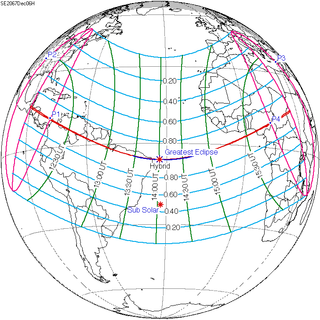| Solar eclipse of December 6, 2067 | |
|---|---|
| Type of eclipse | |
| Nature | Hybrid |
| Gamma | 0.2845 |
| Magnitude | 1.0011 |
| Maximum eclipse | |
| Duration | 8 s (0 min 8 s) |
| Coordinates | 6°00′S 32°24′W / 6°S 32.4°W |
| Max. width of band | 4 km (2.5 mi) |
| Times (UTC) | |
| Greatest eclipse | 14:03:43 |
| References | |
| Saros | 143 (26 of 72) |
| Catalog # (SE5000) | 9659 |
A total solar eclipse will occur at the Moon's ascending node of orbit on Tuesday, December 6, 2067,[1] with a magnitude of 1.0011. It is a hybrid event, beginning and ending as an annular eclipse. A solar eclipse occurs when the Moon passes between Earth and the Sun, thereby totally or partly obscuring the image of the Sun for a viewer on Earth. A total solar eclipse occurs when the Moon's apparent diameter is larger than the Sun's, blocking all direct sunlight, turning day into darkness. Totality occurs in a narrow path across Earth's surface, with the partial solar eclipse visible over a surrounding region thousands of kilometres wide. Occurring about 3.4 days before perigee (on December 10, 2067, at 0:40 UTC), the Moon's apparent diameter will be larger.[2]
The path of the eclipse will be visible as an annular eclipse from parts of southeastern Mexico, Guatemala, southern Belize, Honduras, Nicaragua, Colombia, Venezuela, Brazil, and Guyana before transitioning to a total eclipse. Totality will be visible from parts of Brazil before the eclipse transforms back to an annular eclipse, then passing over Nigeria, Cameroon, Chad, and Sudan. A partial solar eclipse will also be visible for parts of eastern North America, Central America, the Caribbean, northern and central South America, southern Europe, and Africa.
- ^ "December 6, 2067 Total Solar Eclipse". timeanddate. Retrieved 19 August 2024.
- ^ "Moon Distances for London, United Kingdom, England". timeanddate. Retrieved 19 August 2024.
